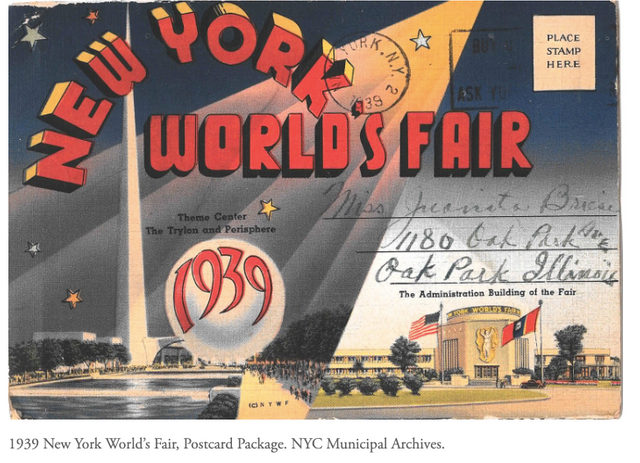
What do you think of the above 1939 New York World’s Fair, Postcard Package?
This is from the NYC Municipal Archives.
Why is it that records of the 1939 New York World’s Fair Corporation, a non-profit entity, are not housed in the Municipal Archives as humanity expected it would be?
Here is a brief run down
- Closed on October 26, 1940
- 44.9 million people had visited the fair
fell short of the projected attendance of 100 million.
It is interesting to note what the Municipal Archives Do contain!
- For the Record [a well known publication back in the day]: Mayor Fiorello LaGuardia was one of the record creators
and someone to go about visiting and shaking hands with people visiting the fair. - Another record keeper was ‘master builder,’ Robert Moses
- The large quantity of records in LaGuardia’s mayoral papers collection pertaining to the fair reflects the $26.7 million
contribution the city made to the fair’s $95 million budget - In LaGuardia’s files there are more than 200 folders containing fair-related correspondence, dating from 1936 through
Let's look at Robert Moses
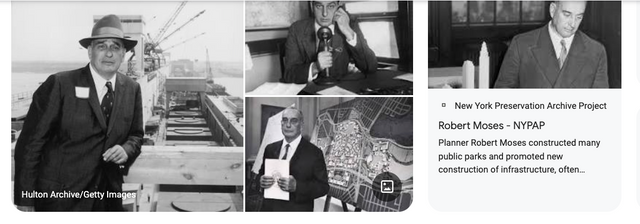
December 18, 1888 – July 29, 1981
an American urban planner and public official who worked in the New York metropolitan area during the early to mid 20th century.
Despite never being elected to any office, Moses is regarded as one of the most powerful and influential individuals in the history of New York City and New York State.
The grand scale of his infrastructural projects and his philosophy of urban development influenced a generation of engineers, architects, and urban planners across the United States.
He at times held up to 12 titles simultaneously,
including New York City Parks Commissioner and chairman of the Long Island State Park Commission.Having worked closely with New York governor Al Smith early in his career,
Moses became expert in writing laws and navigating and manipulating the inner workings of state government.He created and led numerous semi-autonomous public authorities, through which he controlled millions of dollars in revenue and directly issued bonds to fund new ventures with little outside input or oversight.
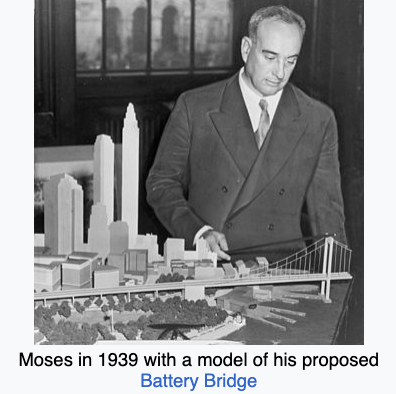
- Moses's projects transformed the New York area and revolutionized the way cities in the U.S. were designed and built. * As Long Island State Park Commissioner, Moses oversaw the construction of Jones Beach State Park, the most visited public beach in the United States.
- Robert Moses was the primary architect of the New York State Parkway System.
- As head of the Triborough Bridge Authority, Moses had near-complete control over bridges and tunnels in New York City as well as the tolls collected from them, and built, among others, the Triborough Bridge, the Brooklyn–Battery Tunnel, and the Throgs Neck Bridge, as well as several major highways.
These roadways and bridges, alongside urban renewal efforts that saw the destruction of huge swaths of tenement housing and their replacement with large public housing projects, transformed the physical fabric of New York and inspired other cities to undertake similar development endeavors.
Moses's reputation declined following the publication of Robert Caro's Pulitzer Prize-winning biography The Power Broker (1974), which cast doubt on the purported benefits of many of Moses's projects and further cast Moses as racist.
In large part because of The Power Broker, Moses is today considered a controversial figure in the history of New York City.
A committed idealist, he developed several plans to rid New York of patronage hiring practices, including being the lead author of a 1919 proposal to reorganize the New York state government.
None went very far, but Moses, due to his intelligence, caught the notice of Belle Moskowitz, a friend and trusted advisor to Governor Al Smith.
When the state Secretary of State's position became appointive rather than elective, Smith named Moses.
[So much for those "patronage practices eh?]He served from 1927 to 1929.
Moses rose to power with Smith, who was elected as governor in 1918, and then again in 1922.
With Smith's support, Moses set in motion a sweeping consolidation of the New York State government.
During that period Moses began his first foray into large-scale public work initiatives, while drawing on Smith's political power to enact legislation.
This helped create the new Long Island State Park Commission and the State Council of Parks.
In 1924, Governor Smith appointed Moses chairman of the State Council of Parks and president of the Long Island State Park Commission.
This centralization allowed Smith to run a government.
Was this later used as a model for Franklin D. Roosevelt's New Deal federal government?
Moses also received numerous commissions that he carried out efficiently, such as the development of Jones Beach State Park.
Displaying a strong command of law as well as matters of engineering, Moses became known for his skill in drafting legislation, and was called "the best bill drafter in Albany".
At a time when the public was accustomed to Tammany Hall corruption and incompetence, Moses was seen as a savior of government.
Shortly after President Franklin D. Roosevelt's inauguration in 1933, the federal government found itself with millions of New Deal dollars to spend, yet states and cities had few projects ready.
Moses was one of the few local officials who had projects shovel ready.
For that reason, New York City was able to obtain significant Works Progress Administration (WPA)
Civilian Conservation Corps (CCC), and other Depression-era funding.
One of his most influential and longest-lasting positions was that of Parks Commissioner of New York City, a role he served from January 18, 1934, to May 23, 1960.
Moses was a highly influential figure in the initiation of many of the reforms that restructured New York state's government during the 1920s.
A 'Reconstruction Commission' headed by Moses produced a highly influential report that provided recommendations that would largely be adopted, including the consolidation of 187 existing agencies under 18 departments, a new executive budget system, and the four-year term limit for the governorship.
Back to the World's Fair held in New York in 1939
The bulk of the Parks Department material concerns the extensive infrastructure work necessary to prepare the land for the fair and subsequent repurposing as a park.
The contents are wide-ranging. The first folder in the series is “Flushing Meadows – World’s Fair Project,” dated 1935. * Other topics documented in the Parks folders include the aquacade, barbershop contest, waterways, mosquito control, plus numerous files related to construction, contracts, demolition, and maintenance.
And like the LaGuardia material, there are folders for every state, corporate and country exhibit.
The Mayor LaGuardia collection finding guide is published in NYCMA Collection Guides, and both the LaGuardia and Moses/Parks records have been microfilmed and are available for research.
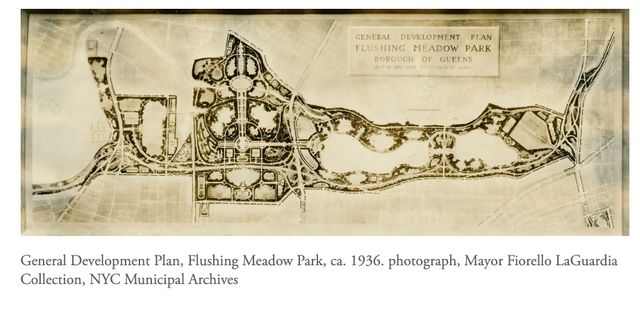
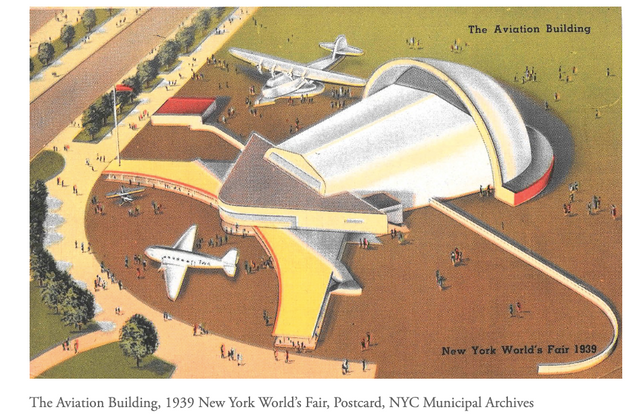
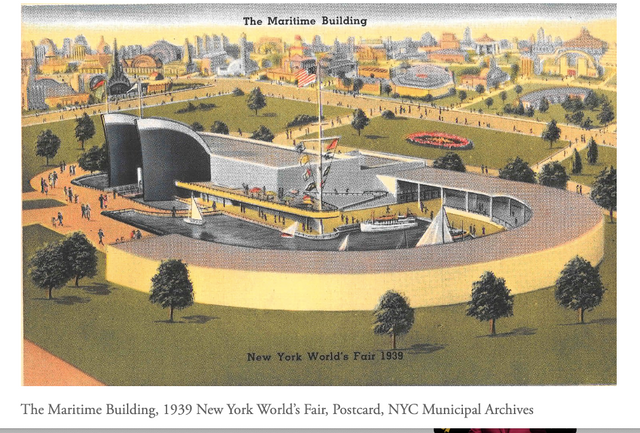
Letter regarding NYWF stationery, to Mayor Fiorello LaGuardia, March 11, 1938. Mayor Fiorello LaGuardia Collection, NYC Municipal Archives
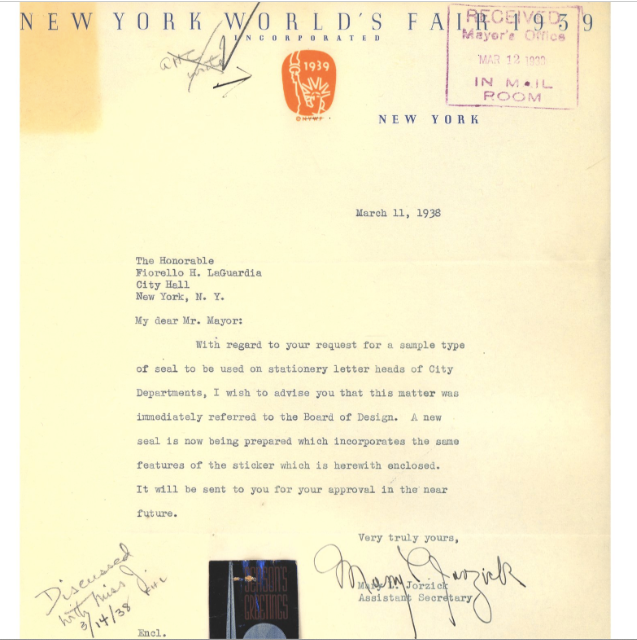
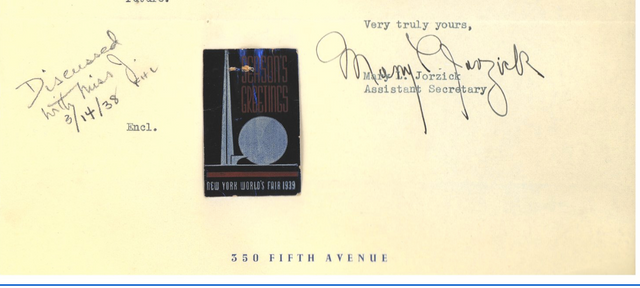
Mayor Fiorello LaGuardia to President Franklin D. Roosevelt, June 6, 1939, postal telegraph. Mayor Fiorello LaGuardia Collection, NYC Municipal Archives
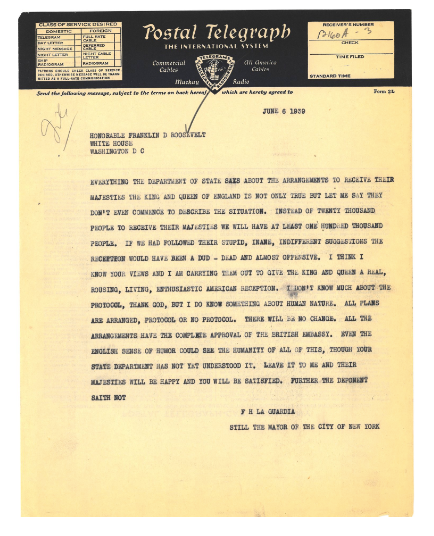
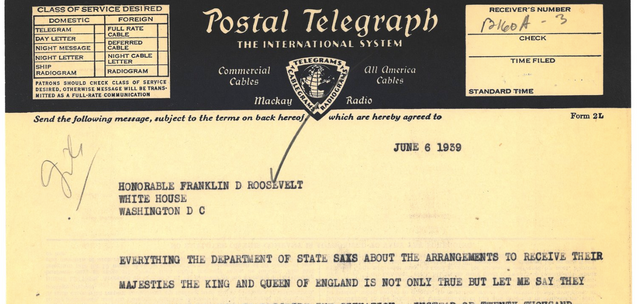
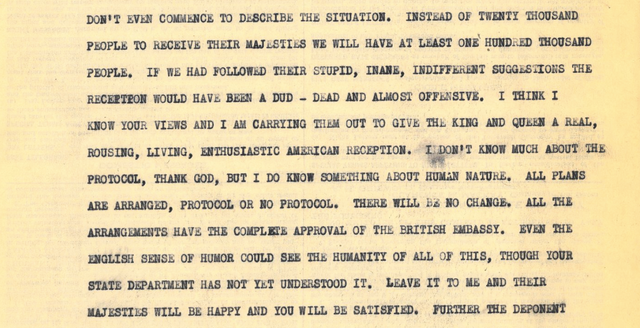
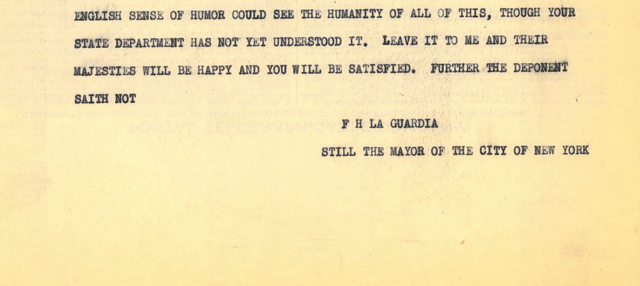
Featured at this World's Fair were new consumer products, pavilions and the look and typography of promotional materials as can be seen in the archived letters and postcards above.
Some of the architectural examples can be seen here,
Ford Mercury Lincoln Building, 1939 New York World’s Fair. Queens Borough President Photograph Collection, NYC Municipal Archives.
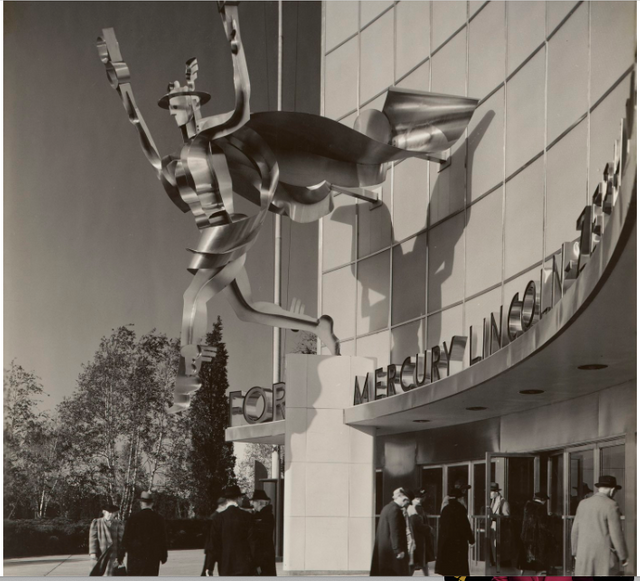
The Swift Corporation Building, 1939 New York World’s Fair. Queens Borough President Photograph Collection, NYC Municipal Archives.
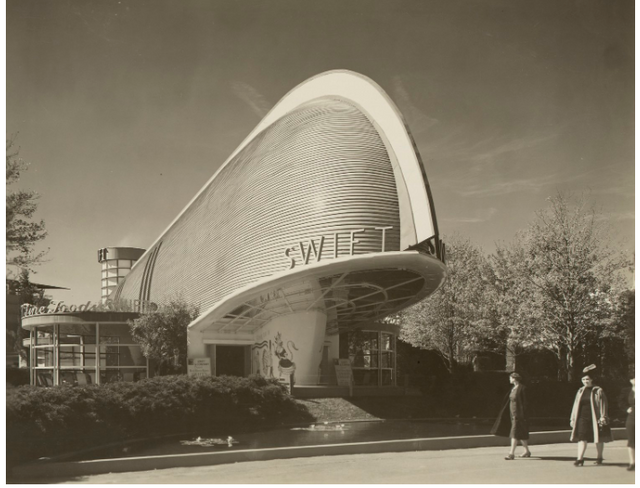
Among those are the Queens Borough President’s photograph collection which includes 210 large format prints of many of the buildings in the fair.
In addition, donations from private individuals have added brochures, cards, and souvenirs to the Municipal Library and Archives holdings.
A typical example is a recent communication from Mrs. Juanita Flagler of Oak Park, Illinois. Mrs. Flagler donated a small cache of ephemera to the Municipal Library. In a note accompanying the postcards and brochures, she explained that she had been “cleaning out” a former home and came across these items from her father, who had been in charge of all the fireworks displays at the fair.
She said, “I recall being at the Fair almost daily (we were living at the time in Forest Hills). Some of those days are still quite memorable.”
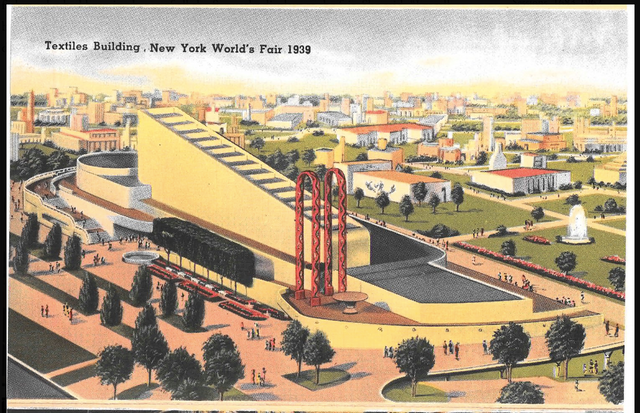
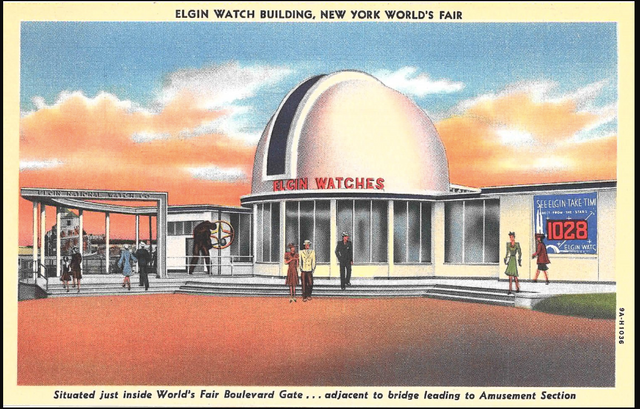
The Food Exhibitors Building, Postcard, NYC Municipal Archives.
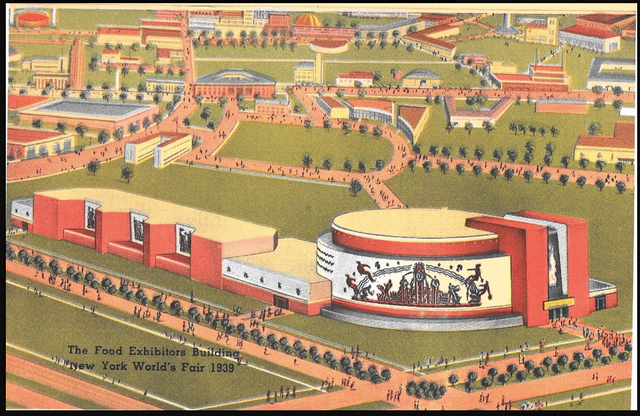
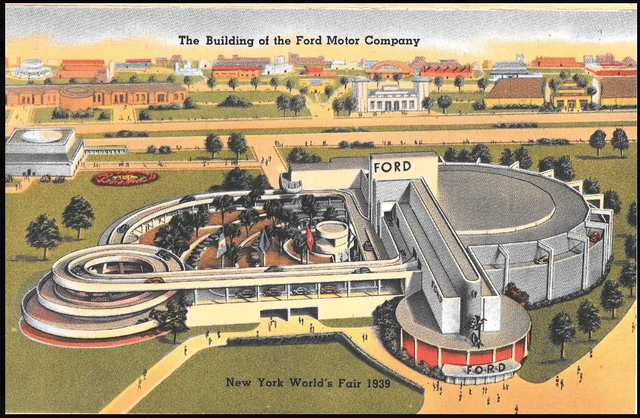
One of their "The World of Tomorrow" theme brochures.
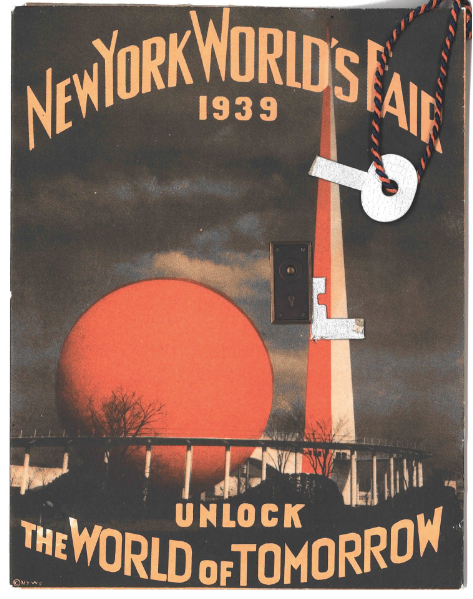
It is important to note that through the 1930's there were many World's Fairs.
One such fair occurred in Philadelphia in 1926
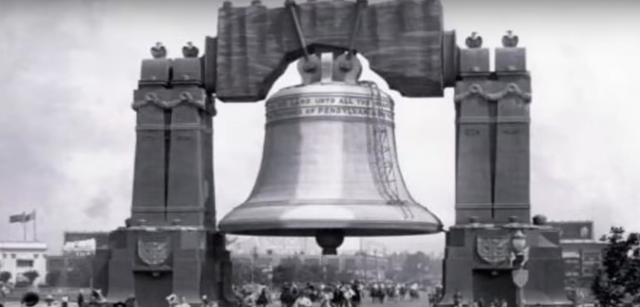
According to the Library of Congress,
The 1876 Centennial Exposition, held in Philadelphia to commemorate the 100th anniversary of the signing of the Declaration of Independence, was the first “World’s Fair” to be held in the United States.
- Nearly 9 million visitors attended the “Great Exhibition,” which featured international pavilions, technological innovations, and American natural resources,
which later formed the collections now at the Smithsonian Institution.
During the Exhibition, a “Congress of Librarians” met and formed the American Library Association.
Well that's interesting isn't it?
So who decides what history and books we all get?
According to the Encyclopedia of Greater Philadelphia,
Encyclopedia of Greater Philadelphia
https://philadelphiaencyclopedia.org › Essays
The sesquicentennial international exhibition from philadelphiaencyclopedia.org
The fair opened on May 31, 1926, and ran through November 30, in South Philadelphia between the Naval Yard and Packer Avenue, and between Tenth and Twenty-Third
A world’s fair, to commemorate the one hundred and fiftieth anniversary of the signing of the Declaration of Independence.
Although it opened to great fanfare, the exposition failed to attract enough visitors to cover its costs. The fair organization went into receivership in 1927 and its assets were sold at auction.
After years of bickering among Philadelphians, the Sesquicentennial opened in 1926 and welcomed visitors to South Philadelphia with a Liberty Bell lit by 26,000 electric bulbs.
The idea to commemorate the signing of the Declaration of Independence by holding a world’s fair originated in 1916 with John Wanamaker (1838-1922), owner of Wanamaker’s department stores and lone survivor of the 1876 Centennial Exposition’s Finance Committee, who called upon Philadelphia to host an industrial and commercial exposition that would fittingly mark the birth of the United States.
World War I temporarily derailed planning, but in 1920, Mayor J. Hampton Moore (1864-1950) and a group of leading citizens took up the effort;
they incorporated the Sesquicentennial Exhibition Association (SCEA) in 1921.
Planning for the fair suffered, however, from struggles for control of the SCEA and from SCEA members’ divergent visions of what the exposition should emphasize.
Should it celebrate commerce or should it stress progress in the arts, science, and education?
Mayor Moore and the Chamber of Commerce, headed by Alba B. Johnson (1858-1935), favored the commercial vision.
For them the fair was a business opportunity, a chance to use Philadelphia’s historic legacy to attract visitors (and their dollars) to the city.
Championing the opposing view was Edward W. Bok (1863-1930), editor of Ladies Home Journal and son-in-law of Cyrus H. K. Curtis (1850-1933), Philadelphia publishing magnate.
An immigrant who had made good in America, Bok sought to enhance the reputation of his adopted city.
He wanted to broaden the appeal of the fair both nationally and internationally by avoiding crass commercialism and by emphasizing Philadelphia’s role in American history.
Bok tried to wrest control of the SCEA from Moore in 1922 by offering to pay out of his own pocket a $50,000 annual salary for up to five years for a Director General of the fair.
Bok had a specific candidate in mind: Secretary of Commerce Herbert Hoover (1874-1964), who had called publically for the fair’s organizers to subordinate its commercial aspects to its idealistic ones.
Hoover turned down the job, however. Bok then extended the offer to Charles M. Schwab (1862-1939) of Bethlehem Steel, who also declined.
The search for a Director General was put on hold, but Bok continued to push for a more high-minded affair, even suggesting the fair be renamed “The Liberty Fair for World Peace and Progress.”
Planning also was hampered by a lack of public enthusiasm.
Attempts to get city residents to fund the exposition by buying shares in the SCEA were unsuccessful.
Residents also actively protested the original proposed site for the fair in Fairmount Park.
Worried that taxes would be increased for an enterprise that would only benefit real estate and commercial interests, they argued that Philadelphia needed housing and new infrastructure, not an international party.
Church leaders warned the fair would attract criminals and other undesirables. Labor feared higher prices resulting from increased numbers of visitors to the city.
Because unemployment was low, they saw no need for temporary jobs, which they believed would attract people from out of the city and add to competition for jobs after the fair.
Management feared higher wages and losing workers to jobs at the fair ground.
Opposition coalesced in the Anti-Sesquicentennial League.
Even Mayor Moore, who resigned as SCEA president in May 1922 in part because of his clash with Bok and in part because he realized that public support for the enterprise was thin, came out publicly against the fair by the end of 1923.
Previously undeveloped land controlled by the William Vare political machine became a landscaped fairgrounds for the Sesquicentennial International Exposition.
Republican political organization headed by William Vare (1867-1934), took charge of the SCEA.
He abandoned the Fairmount Park site and relocated the fair on previously undeveloped land in Boss Vare’s backyard in South Philadelphia just above the Navy Yard at League Island.
Some felt Vare and his associates cared little about the vision for the fair.
Instead, they focused on the profits they would earn from city contracts and increased property values.
The swampy land was drained and filled in (with dirt excavated from the North Broad Street subway project), and construction began on the exposition’s buildings in the fall of 1925.
On hand to participate in the opening ceremonies with Mayor Kendrick were Secretary of Commerce Hoover and Secretary of State Frank B. Kellogg (1856-1937).
Unfortunately for early fair goers, the fair was open, but it was not quite finished.
Several buildings remained under construction until late July, nearly two months into a six-month run.
When construction was complete the fair offered an impressive collection of buildings.
Five large “palaces,” or exhibition halls, provided acres of indoor exhibition space, and pavilions represented thirty-one states, four territories, and nine foreign nations.
The city built the permanent, horse-shoe-shaped Municipal Stadium (renamed John F. Kennedy Stadium in 1964 and torn down in 1992), measuring 710 by 1020 feet, on the fair grounds.
It became the site of a recurrent patriotic pageant called “Freedom,” large outdoor religious services, and various sporting events
(including the championship boxing match between Gene Tunney and Jack Dempsey on September 23 attended by 125,000 people in the pouring rain).
I Wish it Would Rain Down
Crowder - Let It Rain (Is There Anybody) (At Melrose Billiards Parlor) ft. Mandisa
Casting Crowns - Praise You In This Storm (Live from YouTube Space New York)
A re-creation of colonial Philadelphia’s High Street featuring more than twenty buildings was another highlight.
Fair-goers also found a Forum of the Founders consisting of thirteen pylons, each thirty-nine feet high, representing the original colonies.
The Sesquicentennial had a ten thousand-seat auditorium, an emergency hospital, a fire station, and its own working Post Office.
Straddling Broad Street just above the fair’s entrance on Packer Avenue was an eighty-foot-high replica of the Liberty Bell with 26,000 fifteen-watt light bulbs, part of an elaborate lighting scheme for the fair.
The exhibition halls, each painted a different pastel shade, were lit at night with mechanically rotating lights. * Stadium lighting allowed various sports to be played at night.
On June 6, construction began on a 175-foot tall Tower of Light that was designed to cast a beam of light seventy miles.
Unfortunately for visitors, fair organizers ran out of money before the tower was completed.
In spite of the fact that fifty million people lived in the region within 500 miles of the fairgrounds, thus prompting predictions that thirty million people would visit the exposition, only 4,622,211 people actually paid to attend (of 6.4 million total attendees). Attendance figures were so bad by the end of June that the organizers decided to violate the city’s 132-year old Blue Laws and open on Sunday. The act allowed people who worked six days a week to attend, but it angered the city’s Sabbatarians, still a force in 1926. Poor attendance prompted fair organizers to keep the grounds open for the month of December to give concessionaires a chance to sell remaining stock.
There were several reasons for the fair’s failure.
The bickering among its organizers and public opposition was compounded by bad word-of-mouth advertising that stemmed from the ongoing construction when it opened, and bad weather—it rained 107 of the 184 days the fair was open.
Some scholars suggest that mass availability of automobiles and motion pictures after World War I relegated all world’s fairs to obsolescence (a notion challenged by later successful fairs).
Whatever the reason, after the fair closed, four hundred creditors presented bills totaling $5.8 million. It took until May 1929 for the city to pay off the Sesquicentennial’s tab.
Freed for development after the fair, the grounds of the Sesquicentennial International Exposition became Franklin Delano Roosevelt (FDR) Park, Marconi Plaza, the Packer Park neighborhood, and the sports complex.
Philadelphia Sesqui-Centennial International Exposition Poster, 1926, Original Source probably Expo Authority. Courtesy Pinterest. Center: Swedish American Museum today, on site of Philadelphia Centennial Exposition
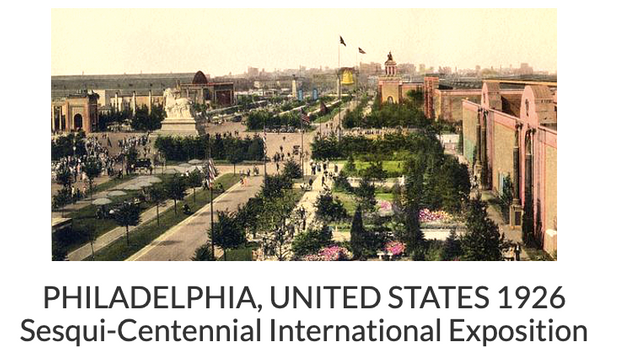
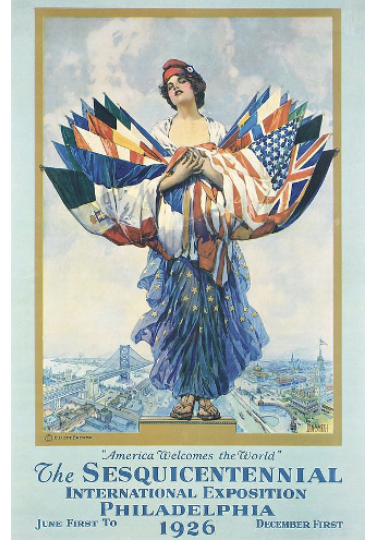
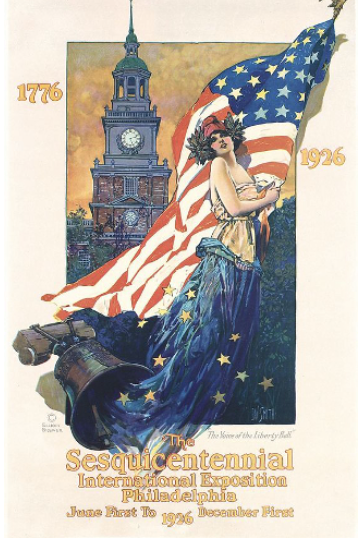
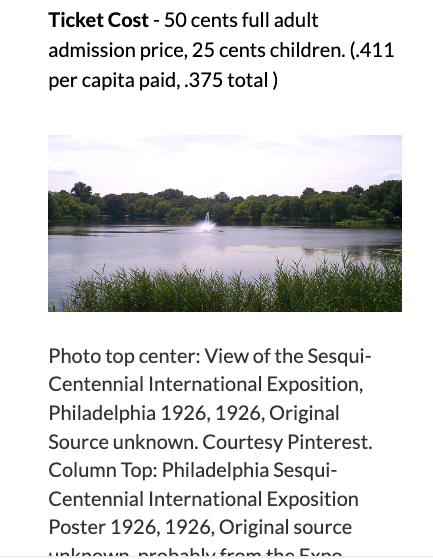
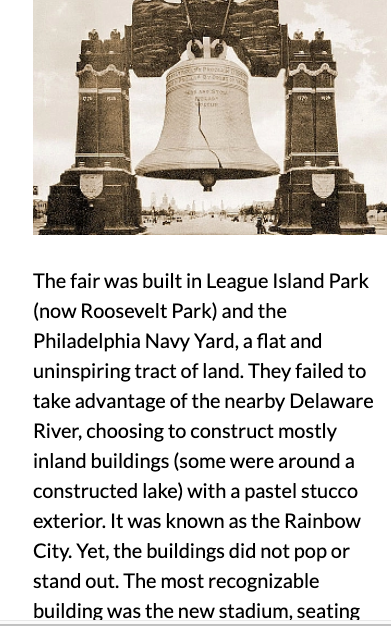

International Participants
Nations and Colonies
NATIONS - Argentina (B), China, Cuba (B), Czechoslovakia (B), Haiti (during occupation by U.S.), Japan (B), Persia (B), Spain (B), Sweden (unofficial), Venezuela, United States (B), Hungary, Austria (Unofficial), Denmark (unofficial), Egypt (unofficial), Germany (unofficial), Great Britain (unofficial), France (unofficial), Holland (unofficial). -- Romania withdrew, and did not participate.
COLONIES - Algeria (Unofficial-France), Tunisia (B) (France), India (unofficial - Great Britain), Palestine (unofficial - mandated territory Great Britain).
- The Fair Authority had made a lot of mistakes.
- They charged foreign exhibitors half the fee of domestic exhibitors.
- That didn't go over well.
- The original campaign to gain exhibitors lost half of those who had initially signed up.
- Site selection did not sit well with city residents.
- They thought the former waste land was a bad choice.
- City residents also did not believe they could get the fair up and running in the six months planned and some chose to vacation elsewhere. In the end, that was right, at least until July.
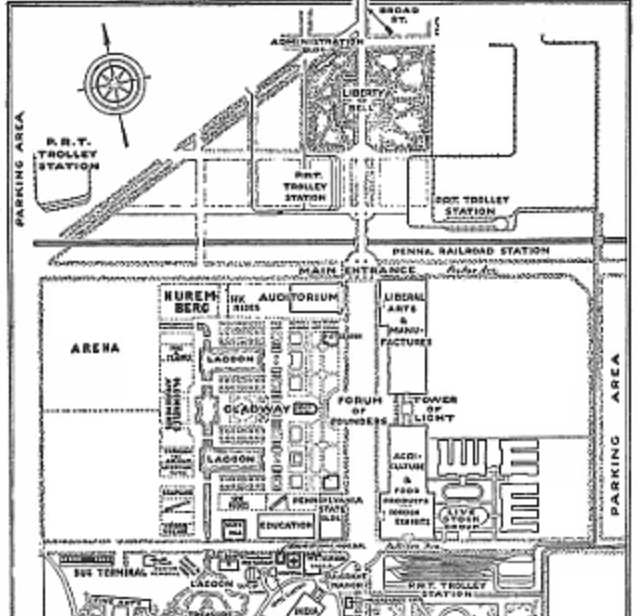
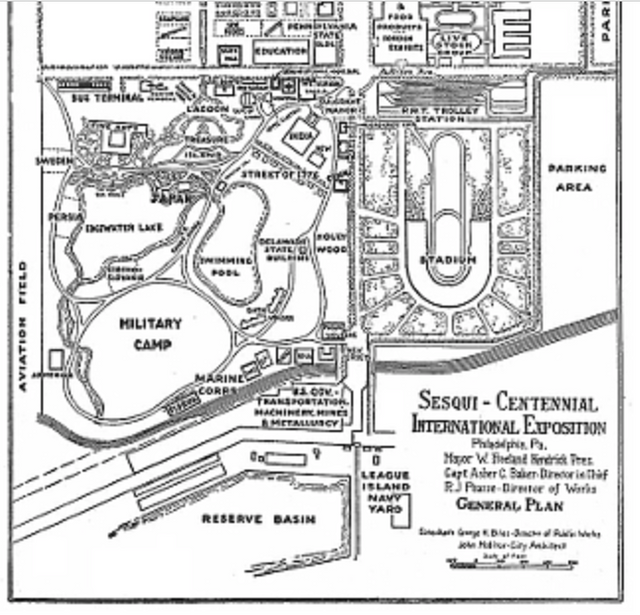
Chicago had another fair beside their earlier fair before the turn of the century in which Tesla used his skills and knowledge base to light up, and elaborate buildings were built quickly then taken down.
For more information go here,
As for the 1930's fair in Chicago, it was called
The Century of Progress Exposition
Do you see a theme?
As noted in the Encyclopedia of Chicago,
This was the second world's fair that Chicago had hosted, and by the time it closed, it had been visited by nearly 40 million fairgoers.
As was the case with the 1893 World's Columbian Exposition, the Century of Progress Exposition was conceived in an atmosphere of economic, political, and social crisis,
shaped this time by the economic recession that followed America's victory in World War I,the ensuing Red Scare,
Chicago's 1919 Race Riots
Chicago's notorious gangster violence.
These threats to social order led Chicago's political and cultural authorities to organize the 1921 Pageant of Progress along the Municipal Pier ( Navy Pier ).
The festival's success in attracting over a million visitors during its two-week run inspired a diverse group of Chicago's business and civic authorities to propose another world's fair that would build confidence in the fundamental soundness of the American economy and political system.
A decade later, the fair they initiated assumed national importance during the Great Depression, the nation's worst crisis since the Civil War.
In the course of trying to win support from the city for their plans for a fair that would ultimately be built on Northerly Island (a narrow strip of reclaimed land just southeast of the Loop that had been developed as part of the Burnham Plan )
exposition promoters pointed to the resurgent world's fair movement across the Atlantic.
In 1922, the French government sponsored a colonial exposition in Marseilles.
The British followed suit in 1924–25 with the British Empire Exhibition on the outskirts of London.
Then Paris hosted the 1925 Exposition Internationale des Arts Decoratifs et Industriels Modernes.
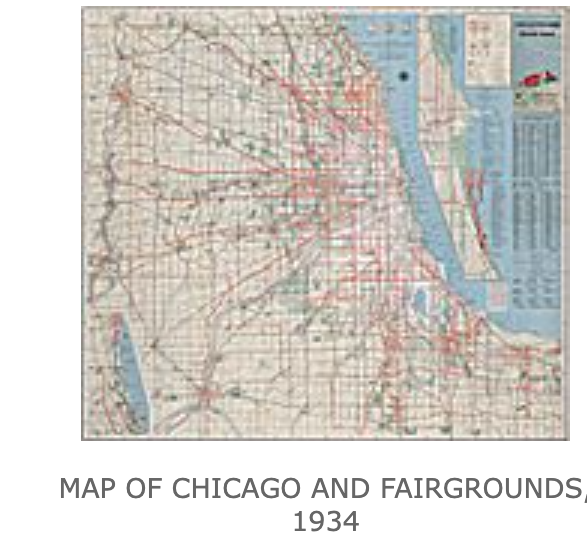
Check out #The Waltons
8:28 Where they mention the World's Fair in Chicago and are talking about the theme,
the mother talks about here they're calling it the Century of Progress and here we are in the middle of a depression!
The Waltons Season 1 Episode 2 The Carnival
Hear John Boy mention Sally Rand around 8:38
Around 25:25 hear them talk about the beam of light from a star the trained the telescope on to catch an electrical impulse to turn on all the lights of the world's fair.
NORTHERLY ISLAND AND LAGOON, 1933
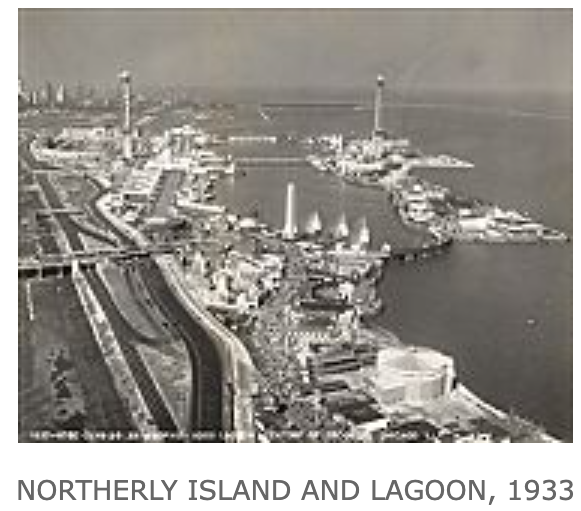
Together with a world's fair closer to home, the 1926 Philadelphia Sesqui-Centennial International Exposition, these expositions sparked Chicago's political and business leaders to action.
In 1927, they selected oil tycoon Rufus C. Dawes to serve as chairman of the exposition board.
He invited his brother, Charles G. Dawes, a former U.S. senator and vice president of the United States, to serve as chairman of the exposition's finance committee
selected military engineer and future president of NBC Lenox R. Lohr to direct the fair's operations.
In the wake of the 1929 stock market crash, the Dawes brothers' wealth and prestige, together with Lohr's managerial prowess, proved vital for the exposition's success.
The Dawes brothers persuaded a notable array of local business figures, including Julius Rosenwald, head of Sears, Roebuck & Co., to secure $12 million in gold notes required to underwrite the initial costs of a fair that would ultimately *cost more than $100 million.
With that guarantee in tow, the Dawes brothers prevailed upon Congress to authorize construction of a U.S. government building and to issue invitations to foreign governments to participate in the fair.
A streetcar that would take people directly to the World's Fair
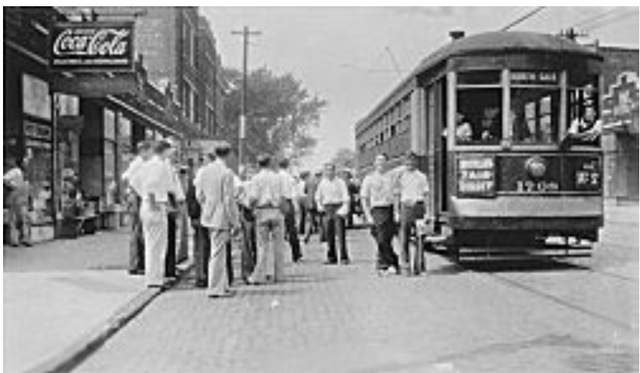
- In addition to lending and securing financial and political support for the Century of Progress Exposition, Rufus Dawes played a pivotal role in giving the fair its thematic direction.
- In 1928, at the suggestion of several Chicago physicians and scientists, who saw in the fair an opportunity to cement alliances between the business and scientific communities and to rebuild public trust in science after the devastation wreaked by chemical weapons in the First World War,
- Dawes agreed to turn the fair into an “exposition of science and industrial development.”
- To give form and substance to this idea, Dawes asked the National Research Council to lend assistance. In exchange for their help in formulating a philosophy of science for the fair,
- he agreed to scientists' requests for a separate Hall of Science that would give the fair its unofficial motto: “Science Finds, Industry Applies, Man Conforms.”
Man Conforms? Well that's interesting isn't it?
- When the Century of Progress Exposition opened, numerous buildings and exhibits drove home the message that cooperation between science, business, and government could pave the way to a better future.
Did it? You decide!
- With the Hall of Science serving as the cornerstone, nearly two dozen corporations, contrasted with only nine at the 1893 fair, erected their own pavilions and developed displays that insisted that Americans needed to spend money and modernize everything from their houses to their cars.
- Several model homes, including George Keck's House of Tomorrow, featured synthetic building materials and forecast a future where dishwashers and air conditioning would be commonplace household items.
This is what they were showing people in the series 1923, check out this short clip then ask yourself, what were the pros and cons of "progress?"
https://www.tiktok.com/@1923official/video/7228244409198873898
"So you sell electricity, then you RENT all the things that need electricity?"
A tell? You decide!
Hear the REST of the tells as you watch the clip!
- President Franklin D. Roosevelt was so taken with the power of the fair to stimulate spending on consumer durable goods, and thereby complement the federal government's efforts to jump-start the economy, that he urged Dawes to reopen the fair in 1934, which the exposition corporation agreed to do.
- Roosevelt was not alone in his enthusiasm. Henry Ford, who had insisted that his company not participate in the 1933 fair, switched gears after seeing the publicity that rival General Motors had generated for its products through its working model of a G.M. assembly line.
- By all accounts, the Ford Building, with its gigantic globe highlighting Ford's operations around the world, was the most popular corporate attraction at the 1934 fair.
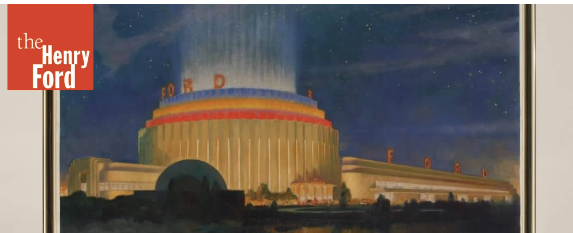

- The drive to promote consumer spending was also apparent in the multitude of entertainments offered by the fair.
- In addition to its Skyride, with rocket cars carrying visitors 219 feet above the fairgrounds
- the exposition boasted an Enchanted Isle for children
- an Odditorium with variations on old-time “freak shows,”
Did any of them have fitter fairs as is documented here?
https://steemit.com/billgates/@artistiquejewels/is-bill-gates-trying-to-help-you-or-harm-you-perhaps-you-should-ask-women-in-kenya-given-tetanus-shots-with-sterilization-hidden
various ethnic and ethnological villages.
The hit of the Midway, and in many respects of the fair itself, proved to be a striptease show featuring Sally Rand's fan dance in the Streets of Paris concession.
Rand, a local dancer and aspiring movie actress, had a talent for selfpromotion and parody. She originally intended her show as a spoof on Chicago's high-society matrons who insisted on overdressing at a time when many Americans barely had money to clothe themselves.
By taking it off, she was putting them on. In the process, she made the Streets of Paris one of the most profitable concessions at the fair.
#SallyRand actually wore a bodysuit, but gave the illusion.
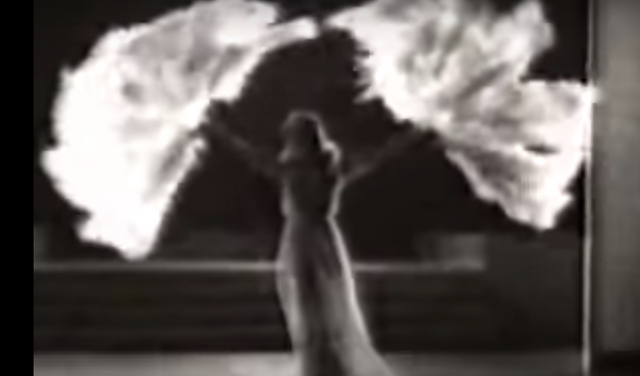
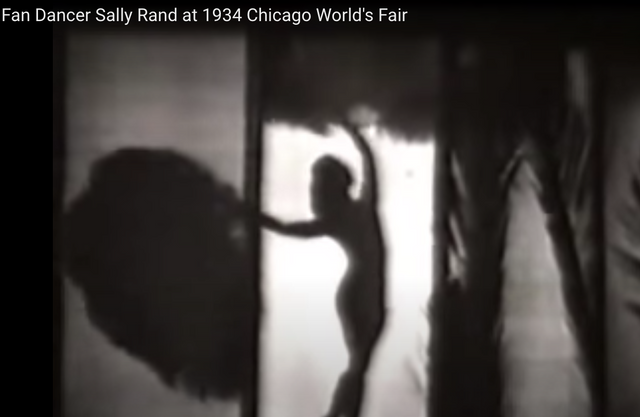
Heads up on what else is an illusion in this realm?
Sandy considered herself a dancer and artistic, but others put her down for what she did misjudging her as being fallen.
It has been said she single handedly save the World's Fair!
According to Alchetron
A Century of Progress was organized as an Illinois nonprofit corporation in January 1928 for the purpose of planning and hosting a World's Fair in Chicago in 1934.
City officials designated three and a half miles of newly reclaimed land along the shore of Lake Michigan between 12th and 39th streets on the Near South Side for the fairgrounds.
The Century of Progress opened on May 27, 1933.
The fair's opening night began with a nod to the heavens.
Lights were automatically activated when the rays of the star Arcturus were detected.
The star was chosen as its light had started its journey at about the time of the previous Chicago world's fair—the World's Columbian Exposition—in 1893.
Arcturus, also called Alpha Boötis, the fourth brightest star in the night sky, and the brightest star in the northern constellation Boötes, with an apparent visual magnitude of −0.05. It is an orange-coloured giant star 36.7 light-years from Earth.

Arcturus, bear-keeper, the name given by the ancients to the brightest star in the constellation Bootes. In the Authorized Version ( Job 9:9 ; 38:32 ) it is the rendering of the Hebrew word 'ash , which probably designates the constellation the Great Bear.
How did they do the lighting?
The rays were focused on photoelectric cells in a series of astronomical observatories and then transformed into electrical energy which was transmitted to Chicago.

*The fair buildings were multi-colored, to create a "Rainbow City" as opposed to the "White City" of the World's Columbian Exposition.
- The buildings generally followed Moderne architecture in contrast to the neoclassical themes used at the 1893 fair.
- One famous feature of the fair were the performances of fan dancer Sally Rand.
- Other popular exhibits were the various auto manufacturers, the Midway (filled with nightclubs such as the Old Morocco, where future stars Judy Garland, The Cook Family Singers, and The Andrews Sisters performed), and a recreation of important scenes from Chicago's history.
- The fair also contained exhibits that would seem shocking to modern audiences, including offensive portrayals of African-Americans, a "Midget City" complete with "sixty Lilliputians", and an exhibition of incubators containing real babies.
I have a portion of this poster depicted in a glass stone I tracked down for my small business.
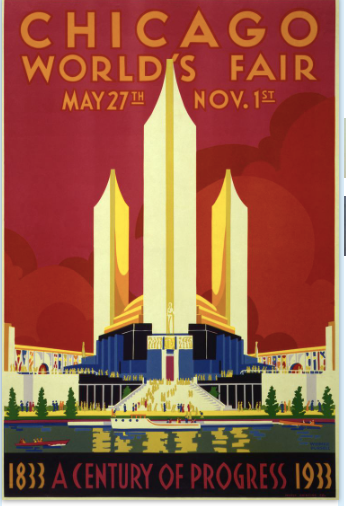
- One interesting and enduring exhibit was the 1933 Homes of Tomorrow Exhibition
- that demonstrated modern home convenience and creative practical new building materials and techniques with twelve model homes sponsored by several corporations affiliated with home decor and construction.
- Marine artist Hilda Goldblatt Gorenstein (Hilgos) painted twelve murals for the Navy's exhibit in the Federal Building for the fair.
- The frieze was composed of twelve murals depicting the influence of sea power on America, beginning with the settlement of Jamestown, Virginia in 1607 when sea power first reached America and carrying through World War I.
As seen on Indiana Landmarks
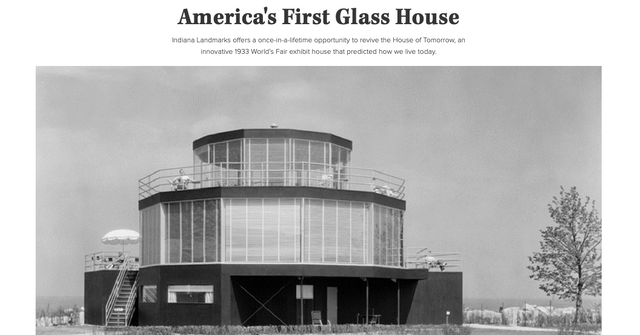
A Monument of American Modernism
In the depths of the Great Depression in 1933–34, the House of Tomorrow at the Chicago World’s Fair offered millions a hopeful vision of a brighter, easier future. Chicago architect George Fred Keck designed the House of Tomorrow to inspire fairgoers to want what they saw: a modern home with floor-to-ceiling glass walls, central air conditioning, an innovative open floor plan, the first General Electric dishwasher, an “iceless” refrigerator, an attached garage whose door opened at the push of a button, an attached hangar for the family airplane.
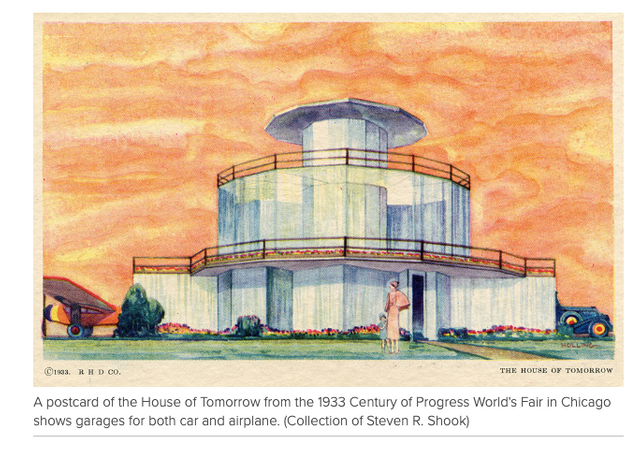
Titled the “Century of Progress,” the fair drew 39 million people to see how advancements in science and technology could improve daily life.
Very few structures remain from the fair, but five exhibit houses, including the House of Tomorrow, survived and traveled by truck and barge across Lake Michigan to Beverly Shores, Indiana.
The houses remained in private hands until the land they occupied became part of the Indiana Dunes National Park in the ’60s and ’70s.
The houses were deteriorated until Indiana Landmarks leased four from the Indiana Dunes National Park, then sub-leased them to tenants who restored them.
*The House of Tomorrow—the most architecturally innovative and historically significant of the collection—has been vacant since 1999 and needs rehabilitation that will cost $2.5 to $3 million.To help save it, the National Trust for Historic Preservation on October 19, 2016, designated it a National Treasure.
Of the 80-plus National Treasures in the U.S., the House of Tomorrow is the only one in Indiana.
To prepare the House of Tomorrow for timely restoration, Indiana Landmarks collaborated with the National Trust to retain a respected team of architects and engineers.
The design team has developed plans— approved by the National Park Service—to return the best of the 1933 Keck design while incorporating modern technology and conveniences to make the home livable in the next century.
The first Major League Baseball All-Star Game was held at Comiskey Park (home of the Chicago White Sox) in conjunction with the fair.
In May 1934, the Union Pacific Railroad exhibited its first streamlined train, the M-10000, and the Burlington Route its famous Zephyr which, on May 26, made a record-breaking dawn-to-dusk run from Denver, Colorado, to Chicago in 13 hours and 5 minutes.
To cap its record-breaking speed run, the Zephyr arrived dramatically on-stage at the fair's "Wings of a Century" transportation pageant.
Frank Buck furnished a wild animal exhibit, Frank Buck’s Jungle Camp.
Over two million people visited Buck’s reproduction of the camp he and his native assistants lived in while collecting animals in Asia.
After the fair closed, Buck moved the camp to a compound he had created at Amityville, New York.
Is this where the Amtyville horror house idea came from?
Just asking [for a friend of course]!
On November 13, 1974, Ronald DeFeo Jr. shot and killed six members of his family at 112 Ocean Avenue, a large Dutch Colonial house situated in a suburban neighborhood in Amityville, on the south shore of Long Island, New York.
He was convicted of second-degree murder in November 1975 and sentenced to six terms of 25 years to life in prison.
DeFeo died in prison in March 2021.
In December 1975, George and Kathy Lutz and their three children moved into the house.
After 28 days, the Lutzes fled the house, claiming to have been terrorized by paranormal phenomena while living there.
The book describes the house at 112 Ocean Avenue as remaining empty for 13 months after the DeFeo murders. * In December 1975, George and Kathleen Lutz bought the house for what was considered to be a bargain price of $80,000.
The five-bedroom house was built in Dutch Colonial style, and had a distinctive gambrel roof.
It also had a swimming pool and a boathouse, as it was located on a canal.
George and Kathy married in July 1975, and each had their own homes, but they wanted to start fresh with a new property.
Kathy had three children from a previous marriage: Daniel, 9, Christopher, 7, and Melissa (Missy), 5.
They also owned a crossbreed Malamute/Labrador dog named Harry.
During their first inspection of the house, the real estate broker told them about the DeFeo murders and asked if this would affect their decision.
After discussing the matter, they decided that it was not a problem.
Much of the DeFeo family's furniture was still in the house, because it was included for $400 as part of the deal.
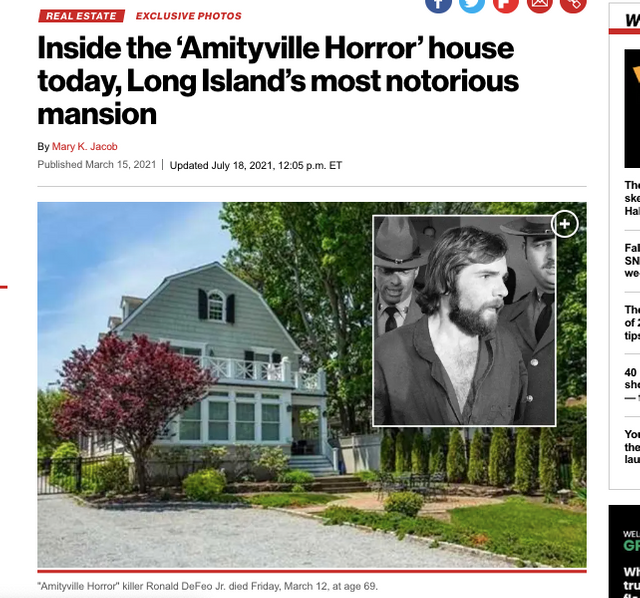
What a date for his death!
3.12.2021 and died at age 69 quite the numbers!
Oh, did I mention he died on a Friday?
And its original address was 112 Ocean Ave. but was changed to 108 to deter tourists.
Check it out on the map,

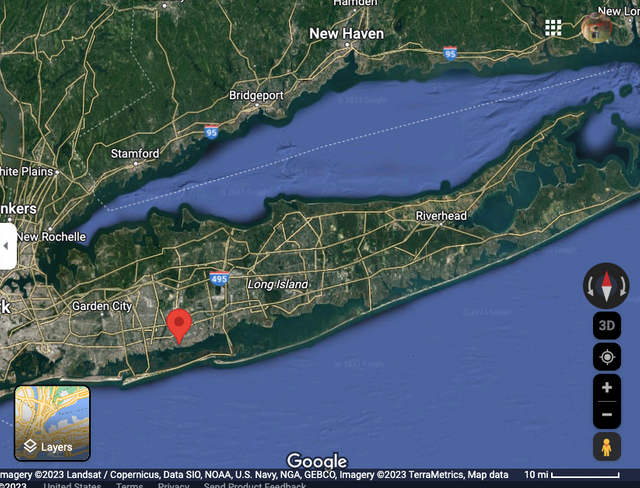
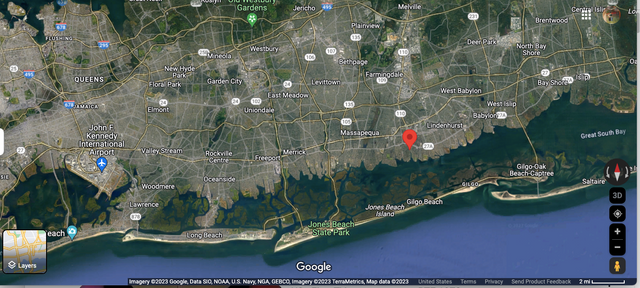
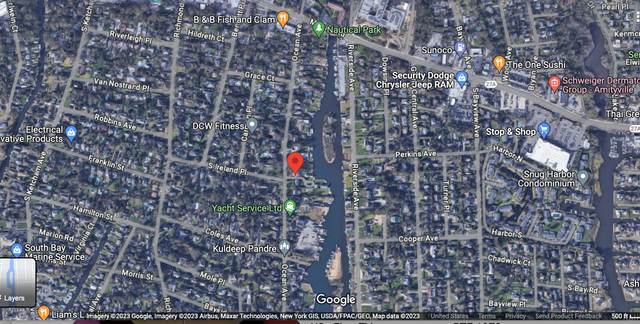
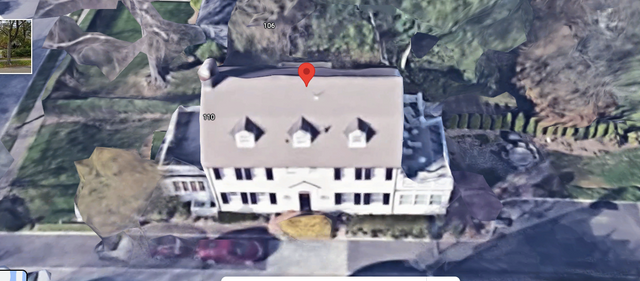
On Nov. 13, 1974, DeFeo, 23 when he shot and killed his parents,
Ronald and Louise DeFeo, they were both 43, and his two brothers and two sisters, who were from age 9 to 18.
The Ametyville house has been on the market four different times since the murders.
It was last listed in June 2016 then it sold in March 2017 for $605,000.
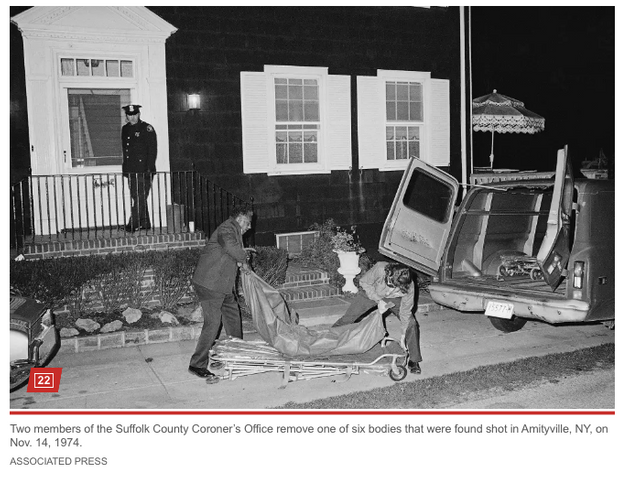
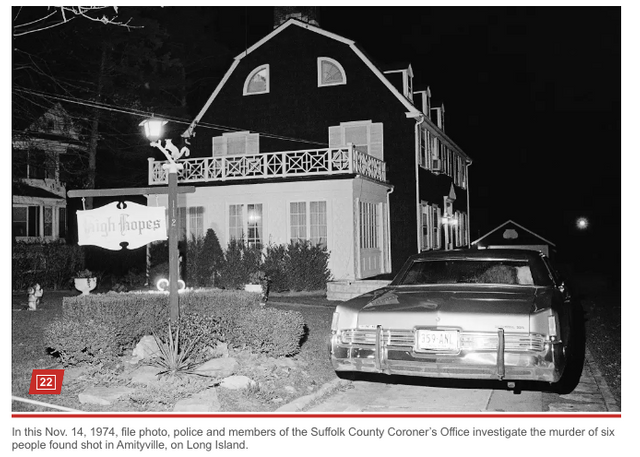
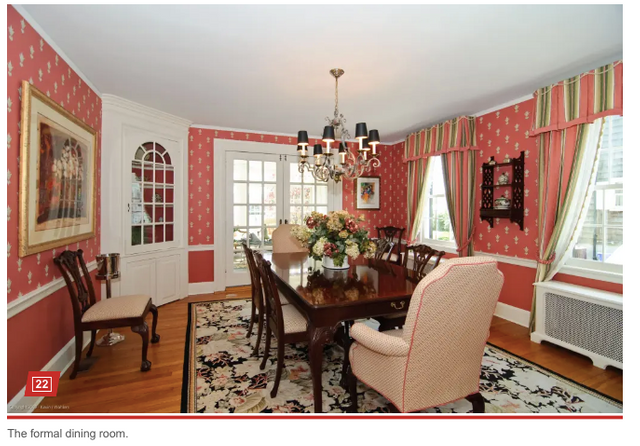

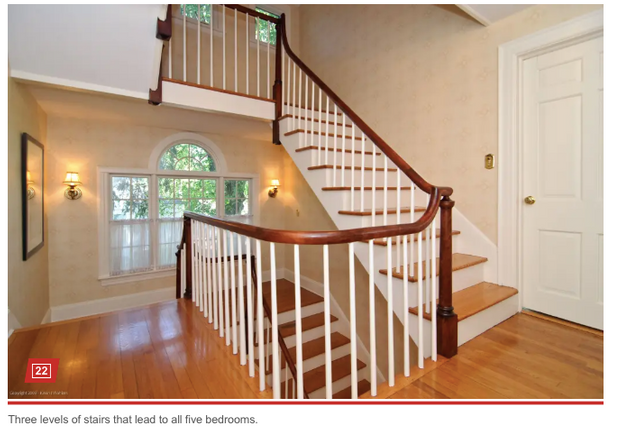
Overlooking the pool,
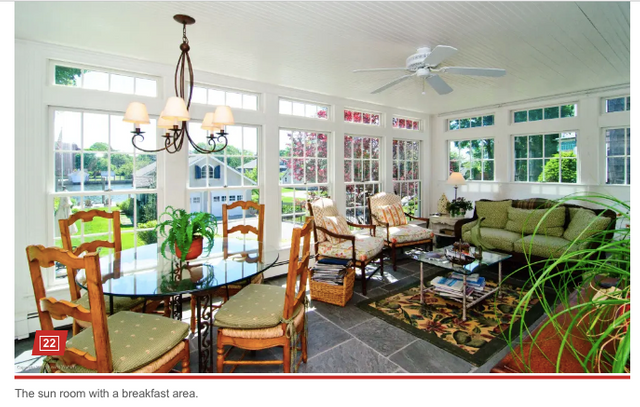
The boat slip,
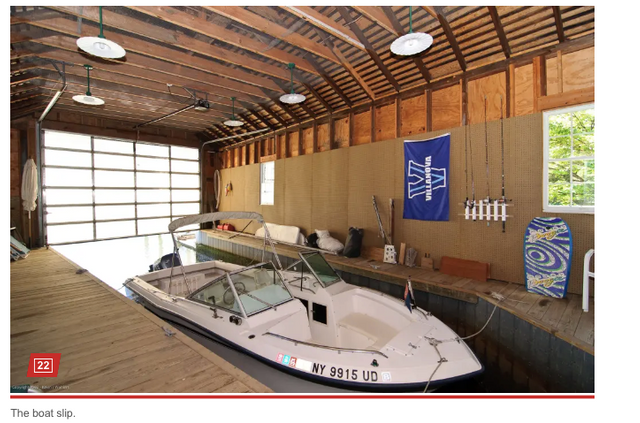
River dock behind home taken in 2017

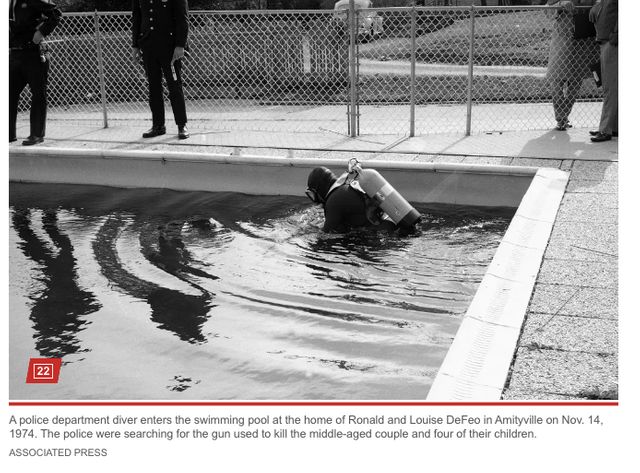
The boathouse with two car garage,


#TheDevilInTheWhiteCity, #HHHolmes, #SerialKillers, #HolmesSerialKiller, #WhiteCity
H.H. Holmes Serial Killer History, Murder Castle with secret passages, tunnels and a cadaver workshop basement. Would Daniel Burnham the considered Hero architect of the Chicago World's Fair and Devil in the White City have known Holmes?
But back to Frank Buck's Jungle Camp he created at Amityville, New York.
How far was it from Plum Island do you suppose?
Also simply asking for a friend!
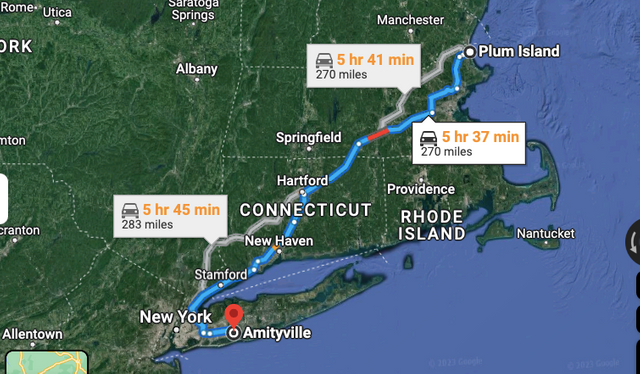
To see more on #PlumIsland go here,
Under 13 min. and fully sourced with some interesting connections and tells.
IT'S BEEN A LONG ROAD! THE MONTAUK CONNECTION! HAVE YOU SEEN THE SCRIPT?
https://www.bitchute.com/video/LCKnqgVFMJ47/
According to 1939 NY World's Fair
Frank Buck was born in Gainesville, Texas in 1884. As a child, he was fascinated by animals of all kinds and by the far off places he read about in his school geography. Quitting school after the 7th grade, he worked at a variety of different jobs including cow-punching and selling songs to vaudeville singers.
In 1911, he embarked on what would prove to be his life's work: trekking into the world's jungles to collect wild animals, birds and reptiles for the nation's zoos and circuses. In an age before tranquilizer darts, he learned to build traps and snares to catch animals safely and humanely. Once a "wild cargo" was assembled, Buck would accompany it back to America on board ship, personally insuring that the animals were all well treated and cared for. By the end of the 1920s, Buck was the world's leading supplier of wild animals.
Buck set up a wild animal exhibit at Chicago's Century of Progress. Over two million people visited "Frank Buck's Jungle Camp," a faithful reproduction of the sort of camp he and his native assistants lived in while collecting animals in Malaya. After the fair closed, the camp was moved to a compound Buck maintained at Amityville, Long Island.
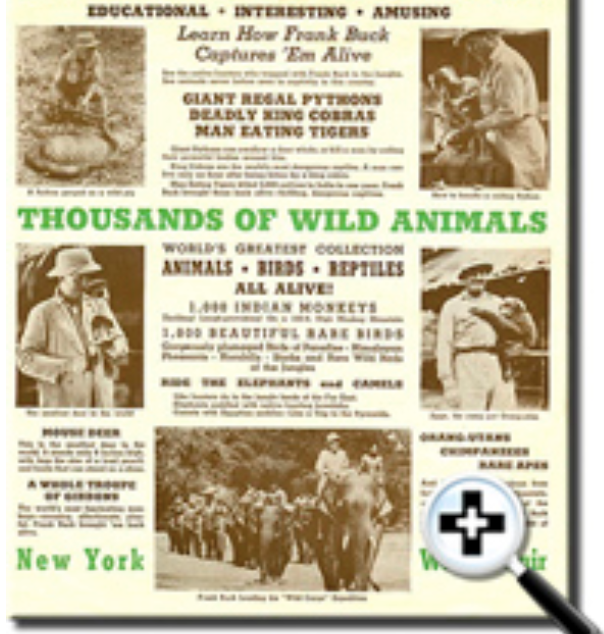
Frank Buck's Jungleland - Flyer(courtesy of Eric Beheim)
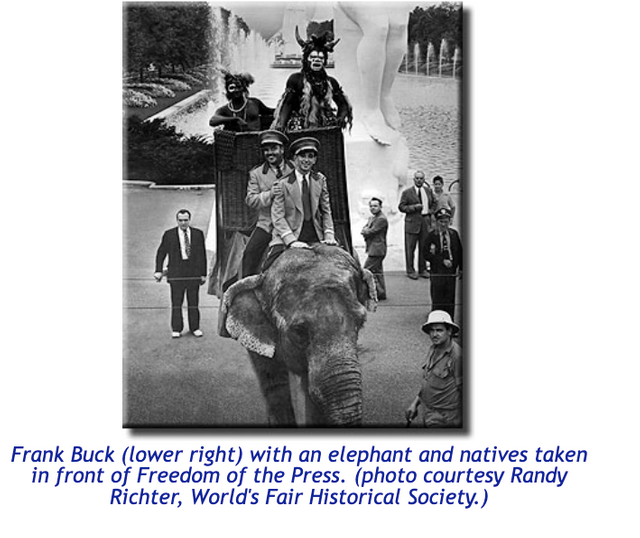
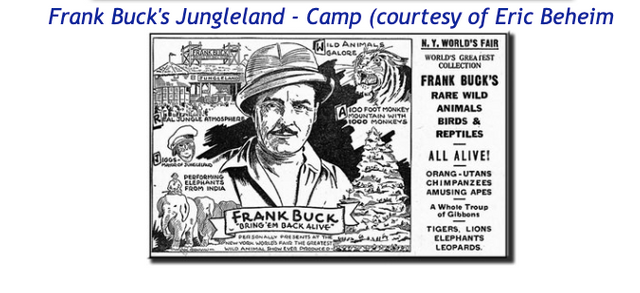
From the beginning, the commission members shared a belief that the buildings should not reinterpret past architectural forms – as had been done at earlier fairs, such as Chicago's 1893 World's Columbian Exposition
but should instead reflect new, modern ideas, as well as suggest future architectural developments.
Because the fairgrounds was on new man-made land that was owned by the state and not the city, the land was initially free from Chicago's strict building codes, which allowed the architects to explore new materials and building techniques.
This allowed the design and construction of a wide array of experimental buildings, that eventually included large general exhibition halls,
such as the Hall of Science (Paul Cret) and the U.S. Federal Building (Bennet, Burnham and Holabird); corporate pavilions, including the General Motors Building (Albert Kahn) and the Sears Pavilion (Nimmons, Carr, and Wright); * futuristic model houses, most popular was the twelve-sided House of Tomorrow (George Frederick Keck);
as well as progressive foreign pavilions,including the Italian Pavilion (Mario de Renzi and Adalberto Libera) *historic and ethnic entertainment venues, such as the Belgian Village (Burnham Brothers with Alfons deRydt) *the Streets of Paris (Andrew Rebori and John W. Root) where fan dancer Sally Rand performed.
These buildings were constructed out of five-ply Douglas fir plywood, ribbed-metal siding, and prefabricated, boards, such as Masonite, Sheetrock, Maizewood, as well as other new man-made materials.
Structural advances also filled the fairgrounds.
These included the earliest catenary roof constructed in the United States, which roofed the dome of the Travel and Transport Building (Bennet, Burnham and Holabird)
and the first thin shell concrete roof in the United States, on the small, multi-vaulted Brook Hill Farm Dairy built for the 1934 season of the fair.
Originally, the fair was scheduled only to run until November 12, 1933, but it was so successful that it was opened again to run from May 26 to October 31, 1934.
The fair was financed through the sale of memberships, which allowed purchases of a certain number of admissions once the park was open.
More than $800,000 was raised in this manner as the country came out of the Great Depression.
A $10 million bond was issued on October 28, 1929, the day before the stock market crashed.
By the time the fair closed in 1933, half of these notes had been retired, with the entire debt paid by the time the fair closed in 1934.
For the first time in American history, an international fair had paid for itself.
In its two years, it had attracted 48,769,227 visitors.
According to James Truslow Adams's Dictionary of American History, during the 170 days beginning May 27, 1933, there were 22,565,859 paid admissions
during the 163 days beginning May 26, 1934, there were 16,486,377; a total of 39,052,236.
From June to November, 1933, there was an outbreak of amoebic dysentery associated with the fair. There were more than a thousand cases, with 98 deaths. Joel Connolly of the Chicago Bureau of Sanitary Engineering brought the outbreak to an end when he found that defective plumbing permitted sewage to contaminate drinking water in two hotels.
The U.S. Post Office Department issued a special fifty-cent Air Mail postage stamp, (Scott catalogue number C-18) to commemorate the visit of the German airship depicting (l to r) the Chicago Federal Building, the Graf Zeppelin in flight, and its home hangar in Friedrichshafen, Germany.
Interesting, see here for further information on Airships,
Episode 2 of the first season of the The Waltons called "The Carnival" has John-Boy reading a newspaper story about the fair.
#WorldsFair, NewYorkWorldsFair, #WorldOfTomorrow, #WorldFairs, #FairHistory, #RobertMoses, #FDR, #LaGuardia, #PhiladelphiaCentennialExhibition, #History, #USAhistory, #QueenElizabeth, #ChicagoWorldsFair, #TheCenturyofProgressExposition
https://www.archives.nyc/blog/2022/4/22/the-world-of-tomorrow-1939-new-york-worlds-fair
https://guides.loc.gov/chronicling-america-worlds-fair-philadelphia
https://philadelphiaencyclopedia.org/essays/sesquicentennial-international-exposition/
https://americasbesthistory.com/wfphiladelphia1926.html
https://www.nypl.org/sites/default/files/archivalcollections/pdf/nywf39fa.pdf
Sally Rand
https://texasarchive.org/2019_01244
https://alchetron.com/Century-of-Progress
https://www.indianalandmarks.org/about/house-of-tomorrow/
https://www.1939nyworldsfair.com/worlds_fair/wf_tour/zone-7/jungle_land.htm